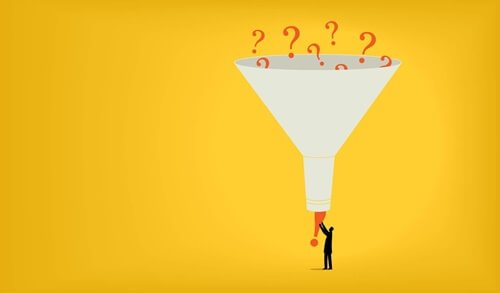The 10-10-10 Rule to Make Decisions

The 10-10-10 rule was designed to help people make tough decisions. We’re talking about those decisions where, if you choose A instead of B, things could either go right or wrong. In these decisions, you basically don’t know what to do and there aren’t any factors that make one option more appealing than the other.
Sometimes the old pro-and-con trick just won’t cut it for those tough decisions. That’s when the 10-10-10 rule comes into play. Suzy Welch invented this method. She’s a journalist who was already famous due to her best-selling books.
Welch carefully studied brain activity during the decision-making process. She found that there’s a very important and negative factor that comes into play. It’s called hyperbolic discounting and it means that we behave as if the future didn’t exist. For example, we eat junk food as if didn’t compromise our health. To stop that bias, Welch created the 10-10-10 rule.
“The risk of a wrong decision is preferable to the terror of indecision.”
-Maimonides-
How does the 10-10-10 rule work?
The 10-10-10 rule starts with asking yourself one question that gives rise to a difficult decision you must make. First, you must clearly define the problem that you want to solve or the decision you must make. For example, “Should I quit my job?”, “Is it time to have another child?”, or “Should I leave my country?”
The more specific you are with the question, the easier it’ll be to make the right decision. It’s better when we know exactly what the essential part of a problem is or the related variables.
The next thing to do is gather some information. You can do this by reading, having conversations, or using any other resource you have at hand. The goal is to identify the main options you have. Your goal? Answering these three simple questions: What are the consequences of each of my options in 10 minutes? And in 10 months? And in 10 years?

The three moments
Don’t take the 10-10-10 rule literally. You don’t need to ask yourself what happens in 10 minutes, 10 months, or 10 years with every single little decision you have to make. This is just a way of picturing how the method works. The goal is to look at the situation in terms of what will happen immediately, later on in the future, and in the long run.
The first moment refers to the consequences of a decision in the here and now. The second moment makes you reflect on a time when the decision has already been made and the first real consequences start to manifest. The third moment has to do with the remote future and the effects of your decision after a lot more time has passed.
Suzy Welch called it the 10-10-10 rule because she wanted it to be a sort of mantra. However, it basically consists of being aware of the moment you’re making the decision, the moment after it’s been made, and the moment when all’s been said and done.

The analysis
Once you’ve visualized the three moments with the 10-10-10 rule, you must make an additional analysis. The information you gathered, the options you have, and your beliefs, goals, dreams, and needs must be part of this analysis. Welch points out that you must ask yourself another question: What’s the option that better helps me take control of my life?
The answer to this question is the final factor that will help you make a decision. The option that best aligns with the future you want is the most appropriate decision.
Not all people get a happy ending with this process. Sometimes decisions involve loss or giving up on certain things. However, if you apply this method right, you’ll eventually feel relieved. Once you discover the best way to grow, you’ll be more motivated to focus your energy on it.
The 10-10-10 rule was designed to help people make tough decisions. We’re talking about those decisions where, if you choose A instead of B, things could either go right or wrong. In these decisions, you basically don’t know what to do and there aren’t any factors that make one option more appealing than the other.
Sometimes the old pro-and-con trick just won’t cut it for those tough decisions. That’s when the 10-10-10 rule comes into play. Suzy Welch invented this method. She’s a journalist who was already famous due to her best-selling books.
Welch carefully studied brain activity during the decision-making process. She found that there’s a very important and negative factor that comes into play. It’s called hyperbolic discounting and it means that we behave as if the future didn’t exist. For example, we eat junk food as if didn’t compromise our health. To stop that bias, Welch created the 10-10-10 rule.
“The risk of a wrong decision is preferable to the terror of indecision.”
-Maimonides-
How does the 10-10-10 rule work?
The 10-10-10 rule starts with asking yourself one question that gives rise to a difficult decision you must make. First, you must clearly define the problem that you want to solve or the decision you must make. For example, “Should I quit my job?”, “Is it time to have another child?”, or “Should I leave my country?”
The more specific you are with the question, the easier it’ll be to make the right decision. It’s better when we know exactly what the essential part of a problem is or the related variables.
The next thing to do is gather some information. You can do this by reading, having conversations, or using any other resource you have at hand. The goal is to identify the main options you have. Your goal? Answering these three simple questions: What are the consequences of each of my options in 10 minutes? And in 10 months? And in 10 years?

The three moments
Don’t take the 10-10-10 rule literally. You don’t need to ask yourself what happens in 10 minutes, 10 months, or 10 years with every single little decision you have to make. This is just a way of picturing how the method works. The goal is to look at the situation in terms of what will happen immediately, later on in the future, and in the long run.
The first moment refers to the consequences of a decision in the here and now. The second moment makes you reflect on a time when the decision has already been made and the first real consequences start to manifest. The third moment has to do with the remote future and the effects of your decision after a lot more time has passed.
Suzy Welch called it the 10-10-10 rule because she wanted it to be a sort of mantra. However, it basically consists of being aware of the moment you’re making the decision, the moment after it’s been made, and the moment when all’s been said and done.

The analysis
Once you’ve visualized the three moments with the 10-10-10 rule, you must make an additional analysis. The information you gathered, the options you have, and your beliefs, goals, dreams, and needs must be part of this analysis. Welch points out that you must ask yourself another question: What’s the option that better helps me take control of my life?
The answer to this question is the final factor that will help you make a decision. The option that best aligns with the future you want is the most appropriate decision.
Not all people get a happy ending with this process. Sometimes decisions involve loss or giving up on certain things. However, if you apply this method right, you’ll eventually feel relieved. Once you discover the best way to grow, you’ll be more motivated to focus your energy on it.
All cited sources were thoroughly reviewed by our team to ensure their quality, reliability, currency, and validity. The bibliography of this article was considered reliable and of academic or scientific accuracy.
Gómez, H. M. R. (2011). Toma de decisiones. (http://dearade.udea.edu.co/aula/pluginfile.php/1150/mod_resource/content/1/Competen cia_Toma_de_Decisiones.pdf.)
This text is provided for informational purposes only and does not replace consultation with a professional. If in doubt, consult your specialist.







